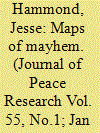| Srl | Item |
| 1 |
ID:
157582


|
|
|
|
|
| Summary/Abstract |
Disaggregated studies of civil violence attempt to predict where violence is most likely to break out within states, but have been limited by a near-exclusive focus on political, economic, and accessibility-based factors in explaining local patterns of violence. These factors are important, but the calculus of military conflict does not focus solely on lootable resources or population distributions. Both states and insurgents try to exert control over geographic territory in order to increase their resource base and political legitimacy. Historic evidence suggests that groups use violence to contest control over strategically important locations that allow them to effectively attack and defend territory. I use GIS and social network analysis to operationalize strategic location based on the network of roads and population settlements that make up a country. I find that during conflicts, locations with high degree and betweenness centrality in the road network – in other words, locations that control access to other areas within the state – are significantly more likely to be fought over, even after controlling for a wide range of variables suggested by previous literature and testing for reporting bias. These findings expand on the previous body of literature studying disaggregated violence and show that the calculus of violence during civil conflict encompasses strategic considerations as well as economic, political, or topographic factors.
|
|
|
|
|
|
|
|
|
|
|
|
|
|
|
|
| 2 |
ID:
151270


|
|
|
|
|
| Summary/Abstract |
Why do most civil wars occur in a relatively small number of countries? We answer this question by analyzing how civil wars diffuse in multiethnic states. Our theory outlines two motivation and two opportunity mechanisms that trigger additional ethnic rebellions in the same state. First, ongoing civil wars motivate members of other ethnic groups to mobilize in reaction to the negative externalities of nearby conflict. Second, ethnic groups emulate nearby rebel groups as a means of addressing preexisting grievances. Third, fighting multiple civil wars drains state capacity, opening the door for additional challengers to rebel against the government. Finally, long-lasting civil wars signal that the state is unable to defeat active rebels, thus creating incentives for new challengers to take up arms. We test our mechanisms in all multiethnic states with a history of armed conflict between 1946 and 2006. Using Geographic Information Systems, we construct overlap and minimum distance measures between ethnic groups’ settlement patterns and conflict zones. Our statistical analysis indicates that new ethnic civil war onsets are more likely in the vicinity of ongoing armed conflicts. Ethnic civil wars also diffuse as governments face an increasing number of rebels and longer rebellions.
|
|
|
|
|
|
|
|
|
|
|
|
|
|
|
|